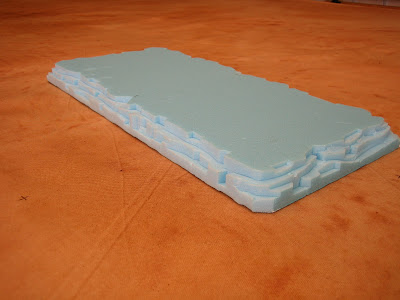If you have been following my desert terrain posts of late, you will know that I stained a large canvas play mat (cut down to 14' 4" x 6' 6" approx) and kept the off cuts for one reason or another. You will also know that because the cloth shrank by 16" in length that I don't have quite as much stained off cut as I would like.
However, although I have now completely run out of stained canvas, I have managed to do my hill tiles for To the Strongest games. For those unfamiliar with To the Strongest, it is a game played out on a grid and consequently, for two reasons, I decided to go for stylised terrain based on the size and shape of the grid squares.
The first reason for my choice of hill shape was to achieve a certain sartorial elegance. The game is based on a square grid so why not embrace it.
The second reason, and the reason my hills are so square, is down to cost. Originally I had planned to do my hills in a similar fashion but with less regularity of shape and I had planned on buying new foam insulation board to do it. However, a box of twelve one inch thick tiles two foot square is nearly £80.00 including delivery, VAT, etc.
As I only actually needed three or four tiles this was too much, especially as I already had sufficient 'spacer sections' in my collection of under cloth hills tiles for 'green terrain' from which to make my desert hills. These sections are unpainted square edged lengths (to increase the width / length of hills) and could be easily converted into painted sections for going on top of the table for TtS desert games, whilst still maintaining their usefulness as spacers when going under a green cloth where their true identity cannot be seen. A simple case of double bubble. A side benefit of double bubble hill sections is of course storage space requirements - hills being one of those terrain features that require quite a lot of storage space.
Having decided on a basic design and working out that I had cloth for 21 squares worth of sections, I made a simple plan of what to make. I drew out the sections I would cut and shape on a piece of paper, and changed my plan after a little thought to add two one square spacers.The edges were now sealed with thin filler mix. Creamy texture with a 1:1 PVA water solution. This is important. Thick filler is much easier to apply onto a coated surface.
Filler was a cheap brand (2Kg for £4) and cheap PVA which I mostly buy to do sand and grit basing: It's quite runny.
Then the thicker filler is applied to rough up the surface. I used a hog hair brush to get the effect. Again filler is mixed with a 1:1 PVA water solution. This is important as it will stop the filler chipping when in use - it's all glued together.
Warping hasn't ever proved much of an issue with this technique but, until the filler was dry I wasn't taking any chances. The tiles were stacked on a level surface under two glass shelves and weights (a few books).
When the plaster was dry I painted the 'rock faces'. I did this as a two part operation. Firstly I did the bottom of the cliff going under half an inch onto the base to seal everything, placing the hill upside down to dry. Then I did the top half (as pictured) doing the same.
First drybrush. Done using a big (size 8) flat hog hair brush.
Followed by a second and third highlight using a Magnolia, first mixed with WH2 for the second highlight, then applied neat.
Next the top surface was applied. This would be canvas offcuts stained when the cloth was done. A thin coat of PVA was applied to the top surface of the tile and also to the leading edges of the fabric.
Up until this point everything was straight forward and quick. Now the hassle began. I had to cut off the excess canvas from around the edge of the hill. For this I used a scalpel.
Consequently, I decided to stylise the hill.
One possible combination of 21 squares of hill sections.
And slightly less hills in a game set up.















3 comments:
Those hills look superb
Very effective James and they blend in nicely:)
Visit for Tiles
Post a Comment